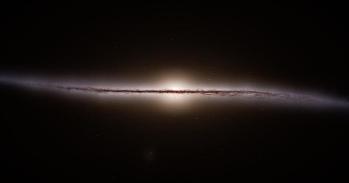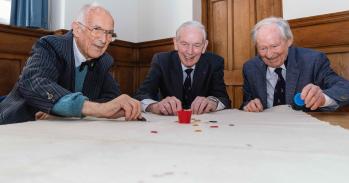
Advances in telescope technology being developed at Cambridge will drive a revolutionary period of discovery in astronomy.
Advances in telescope technology being developed at Cambridge will drive a revolutionary period of discovery in astronomy.
We’ll be able to look for evidence of unintentional radio emissions, the equivalent of airport radar, from our nearby stars and planetary systems that may indicate intelligent life.
How do planetary systems form? What do the surfaces of stars look like? Does life exist elsewhere in the Universe? Astronomers have developed many theoretical models, but until now the ability to validate these with observations has been severely constrained by the telescope capabilities available.
Taking the lead in three major new international projects, Cambridge astronomers are tackling the enormous technical challenges involved in developing bigger and better telescopes to open new windows onto the Universe. Building on Cambridge’s strong legacy of achievement in astronomical instrumentation, the new telescopes all utilise one important underlying technique –interferometry by aperture synthesis – to probe the Universe at a level of detail far beyond the capabilities of any telescope currently in existence. Each telescope will detect light at a different wavelength and help to build a fuller picture of exactly what is out there.
Filling in the detail
“When we look at regions of star formation with the best existing high-frequency radio telescope, we see blobs. We can learn a lot by looking at the radio waves that come out of these, but inside there will be all sorts of complicated structures that the telescope can’t resolve,” said Dr John Richer, astrophysicist at the Cavendish Laboratory and the Kavli Institute for Cosmology.
Richer is UK Project Scientist for the Atacama Large Millimetre Array (ALMA), a partnership project involving Europe, North America, East Asia and the Republic of Chile. Currently under construction in Chile, this revolutionary sub-millimetre radio telescope will consist of 66 high-precision antennas working in perfect synchrony when fully operational in 2013.
Interferometry will be used to combine the information they collect, ‘synthesising’ an aperture with an effective diameter of 16 km to create an ultra-high-resolution telescope. Professor Richard Hills, who is currently on secondment in Chile, designed the set of radio receivers that calibrate the telescope and are central to ALMA achieving its scientific goals, and Richer’s team is developing the software to correct the images from ALMA.
“ALMA is an incredible piece of engineering that will enable us to zoom in to take pictures with a thousand times better resolution than we can now, so we’ll actually see all the detailed structure instead of blobs,” said Richer. “We’re hoping to unlock the secret of how planetary systems form, and to look back in time at the very early Universe.”
With 33 of the antennas currently operational, the telescope is already returning stunning images. “The whole astronomical community wants to use ALMA because it’s unique, and a huge breakthrough in capabilities,” said Richer. “There’s an unprecedented level of oversubscription, because nearly everything in the Universe has some emission at these radio wavelengths that is interesting and not well understood.”
Building a fuller picture
Dr David Buscher and Professor Chris Haniff, astrophysicists at the Cavendish Laboratory, are system architects for the Magdalena Ridge Observatory Interferometer (MROI), a collaborative project with New Mexico Tech, USA, that also uses interferometry, but this time at visible wavelengths.
“Optical interferometry provides information not available from conventional optical telescopes or from radio interferometers,” said Buscher. “Both radio and optical interferometers can see fine detail: putting together this detail allows us to answer new questions.”
The pair started with a set of high-level scientific questions, drawn up by a consortium of UK astrophysicists, and used these to specify a new high-precision optical array. “The great thing about this project is that we’ve been able to design and build, from scratch, an instrument to answer fundamental scientific questions that cannot be answered in any other way,” said Buscher. Haniff added: “We are involved in all the major design questions, from what size telescopes are the best, to how many, to which configuration would produce the best images, and we’re developing the software that will make images from the data.”
When constructed on its mountain-top site in New Mexico, the MROI will be the lead instrument in its field, consisting of 10 telescopes that will produce images with 100 times the resolution of those from the Hubble Space Telescope. By looking at external galaxies, it is expected to revolutionise understanding of astrophysical phenomena ranging from active galactic nuclei to black holes. Closer to Earth, it will help answer questions about the formation of stars and planets.
“There are models for what’s going on,” said Haniff, “but these could be completely wrong – at the moment the detail is far too fine to see. By using interferometry to simulate the resolving power of a single optical telescope of up to 340 m in diameter, the MROI will enable us to see structures that are so small they couldn’t otherwise be detected at visible wavelengths.” The advanced technology of the MROI could also have important commercial applications, such as in taking images of broken telecommunications satellites in geostationary orbit to help diagnose what has gone wrong.
Signs of life?
The third telescope in the trio, the Square Kilometer Array (SKA), will be the largest and most sensitive radio telescope ever, and its design involves astronomers, engineers and industry partners from 20 countries. Professor Paul Alexander, Head of Astrophysics at the Cavendish Laboratory, is playing a leading role in its development. Involving a ‘sea’ of antennas – over half a million in the first phase – acting as one enormous interferometer covering 1 km2, the concept calls for a very simple design with low unit cost. “At the moment we’re working very closely with our industrial partner, Cambridge Consultants, on the detailed design,” he said. “It’s also going to be a major computing challenge – the data transport from the dishes will produce 10 times the current global internet traffic.”
With one of its design goals being “to maximise the ability to explore the unknown”, SKA will enable astronomers to see incredibly faint signals. “With SKA we will be able to look back to the time when the first objects formed in the Universe, and try to understand how we got from there to what we have now,” explained Alexander. “A second experiment will use pulsars, originally discovered by Antony Hewish and Jocelyn Bell-Burnell in Cambridge, as extremely accurate natural clocks. Finding a pulsar in orbit around a black hole will enable us to properly test Einstein’s gravitational theory.”
This extremely powerful telescope also provides an exciting new approach to the search for extra-terrestrial intelligence (SETI). “The trouble with most SETI searches is that they rely on someone communicating with you just at the time when you’re listening,” said Alexander. “SKA is so much more sensitive than anything we’ve had before. We’ll be able to look for evidence of unintentional radio emissions, the equivalent of airport radar, from our nearby stars and planetary systems that may indicate intelligent life.”
Although work on SKA has already begun, construction will not start until 2016 and the telescope will not be fully operational until 2024. Development work for all three telescopes extends back decades, as Alexander explained: “We’re building on our legacy”. The idea for interferometry was originally conceived in the 1880s, but it wasn’t until the 1950s that it was developed and used at radio wavelengths – a technique for which Cambridge astronomers Martin Ryle and Antony Hewish won a Nobel Prize in 1974. It was also in Cambridge in the 1980s that reliable interferometric imaging was first shown to be feasible at optical wavelengths, and this paved the way for building the MROI.
A challenge of many disciplines
“To build these big telescopes you need teams of people with expertise across astronomy, technology and computing,” explained Alexander. “You’ve got to pull everyone together to do good, competitive science”. Recognising this, the University plans to build a new Centre for Experimental Astrophysics to enable greater integration of its strengths. Construction of the Centre will begin this October on a site adjacent to the University’s Kavli Institute, thanks to generous philanthropic support from Cavendish Alumnus Mr Humphrey Battcock and The Wolfson Foundation. “The new building will enable us to create the teams needed to take on these big scientific challenges, which will lead to major advances in our knowledge and understanding of the Universe,” said Alexander.
This work is licensed under a Creative Commons Licence. If you use this content on your site please link back to this page.





